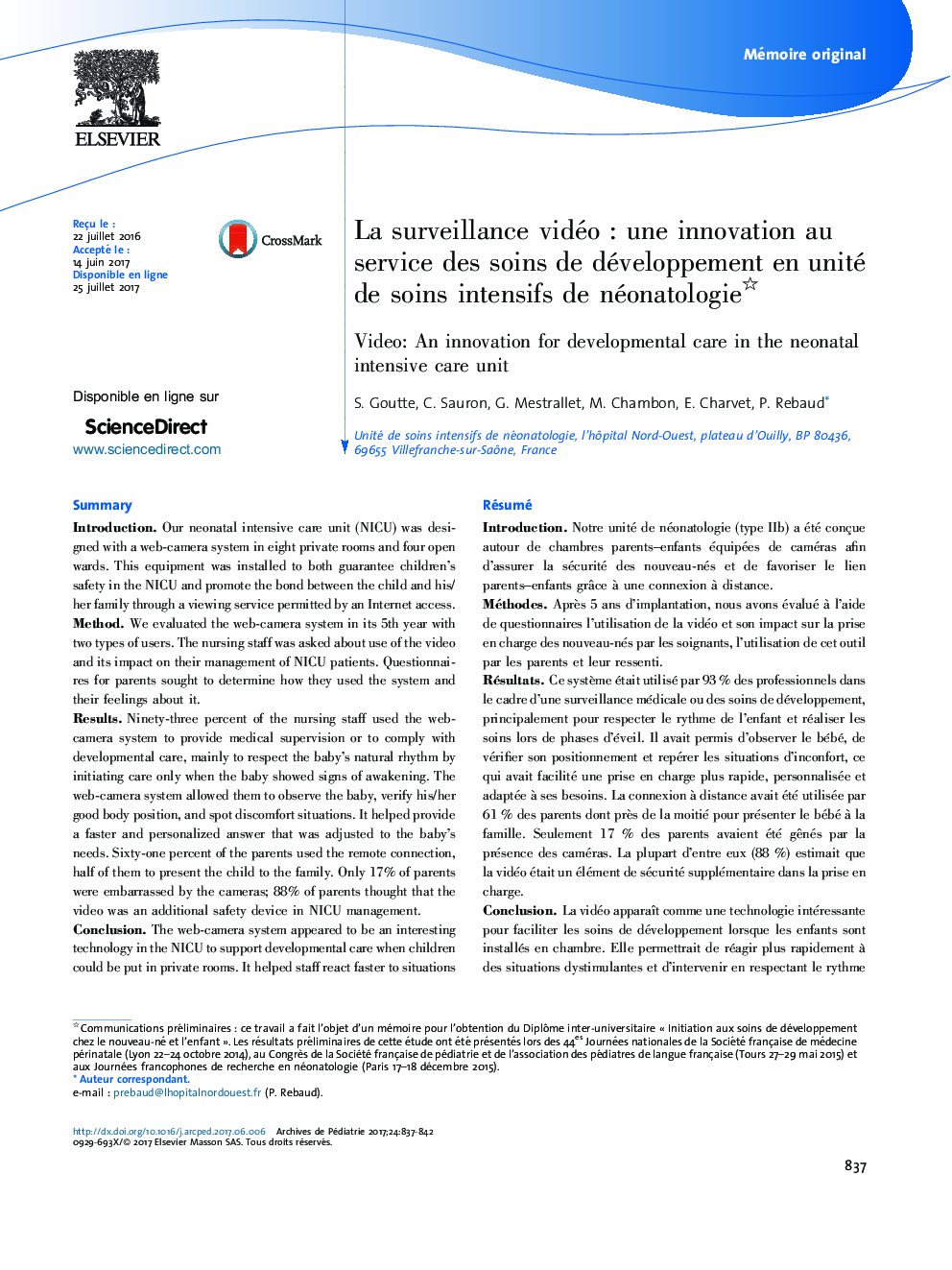| Article ID | Journal | Published Year | Pages | File Type |
|---|---|---|---|---|
| 5717372 | Archives de Pédiatrie | 2017 | 6 Pages |
RésuméIntroductionNotre unité de néonatologie (type IIb) a été conçue autour de chambres parents-enfants équipées de caméras afin d'assurer la sécurité des nouveau-nés et de favoriser le lien parents-enfants grâce à une connexion à distance.MéthodesAprès 5 ans d'implantation, nous avons évalué à l'aide de questionnaires l'utilisation de la vidéo et son impact sur la prise en charge des nouveau-nés par les soignants, l'utilisation de cet outil par les parents et leur ressenti.RésultatsCe système était utilisé par 93 % des professionnels dans le cadre d'une surveillance médicale ou des soins de développement, principalement pour respecter le rythme de l'enfant et réaliser les soins lors de phases d'éveil. Il avait permis d'observer le bébé, de vérifier son positionnement et repérer les situations d'inconfort, ce qui avait facilité une prise en charge plus rapide, personnalisée et adaptée à ses besoins. La connexion à distance avait été utilisée par 61 % des parents dont près de la moitié pour présenter le bébé à la famille. Seulement 17 % des parents avaient été gênés par la présence des caméras. La plupart d'entre eux (88 %) estimait que la vidéo était un élément de sécurité supplémentaire dans la prise en charge.ConclusionLa vidéo apparaît comme une technologie intéressante pour faciliter les soins de développement lorsque les enfants sont installés en chambre. Elle permettrait de réagir plus rapidement à des situations dystimulantes et d'intervenir en respectant le rythme propre de chaque nouveau-né. Elle rassurerait les professionnels et les parents, faciliterait l'accueil de l'enfant dans la famille.
SummaryIntroductionOur neonatal intensive care unit (NICU) was designed with a web-camera system in eight private rooms and four open wards. This equipment was installed to both guarantee children's safety in the NICU and promote the bond between the child and his/her family through a viewing service permitted by an Internet access.MethodWe evaluated the web-camera system in its 5th year with two types of users. The nursing staff was asked about use of the video and its impact on their management of NICU patients. Questionnaires for parents sought to determine how they used the system and their feelings about it.ResultsNinety-three percent of the nursing staff used the web-camera system to provide medical supervision or to comply with developmental care, mainly to respect the baby's natural rhythm by initiating care only when the baby showed signs of awakening. The web-camera system allowed them to observe the baby, verify his/her good body position, and spot discomfort situations. It helped provide a faster and personalized answer that was adjusted to the baby's needs. Sixty-one percent of the parents used the remote connection, half of them to present the child to the family. Only 17% of parents were embarrassed by the cameras; 88% of parents thought that the video was an additional safety device in NICU management.ConclusionThe web-camera system appeared to be an interesting technology in the NICU to support developmental care when children could be put in private rooms. It helped staff react faster to situations that created an inappropriate stimulation for the baby. It also allowed to them to respect the baby's natural rhythm. It reassured nursing staff and parents and it facilitated the baby's integration into the family.
